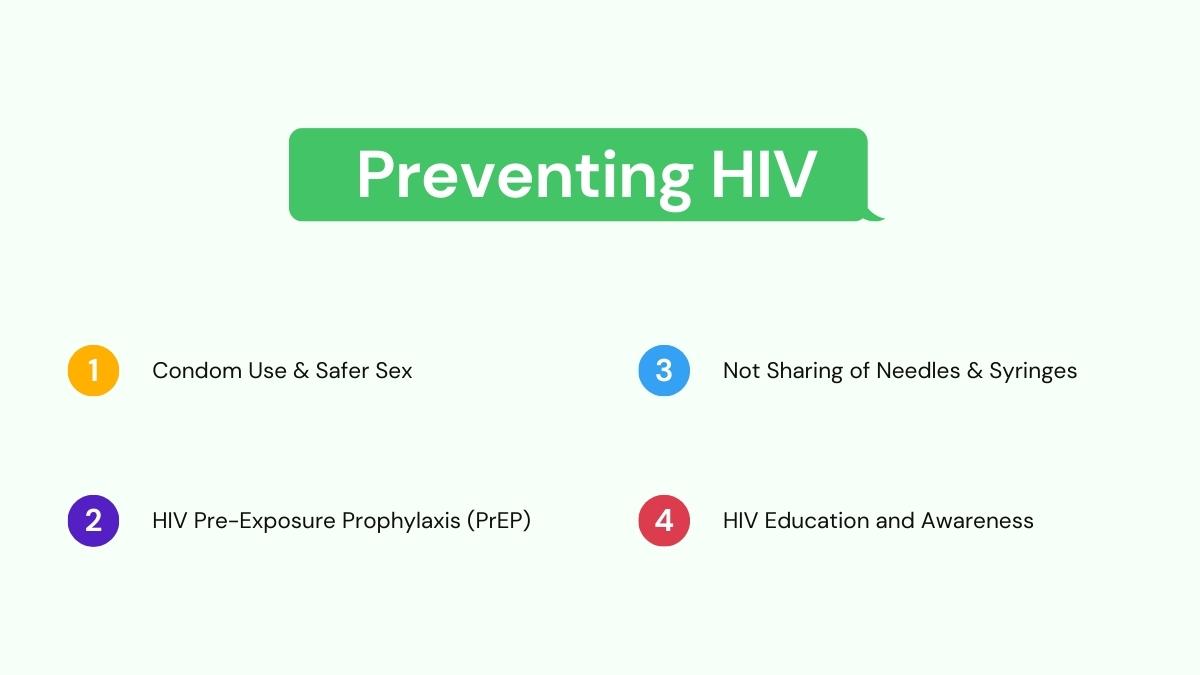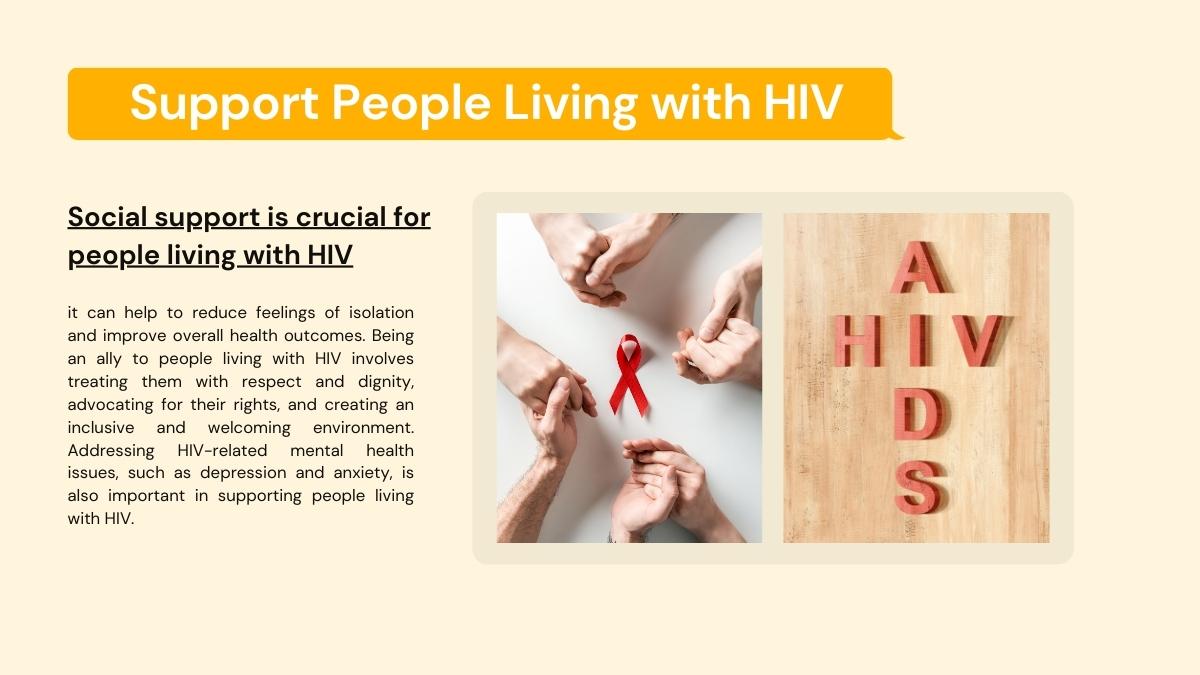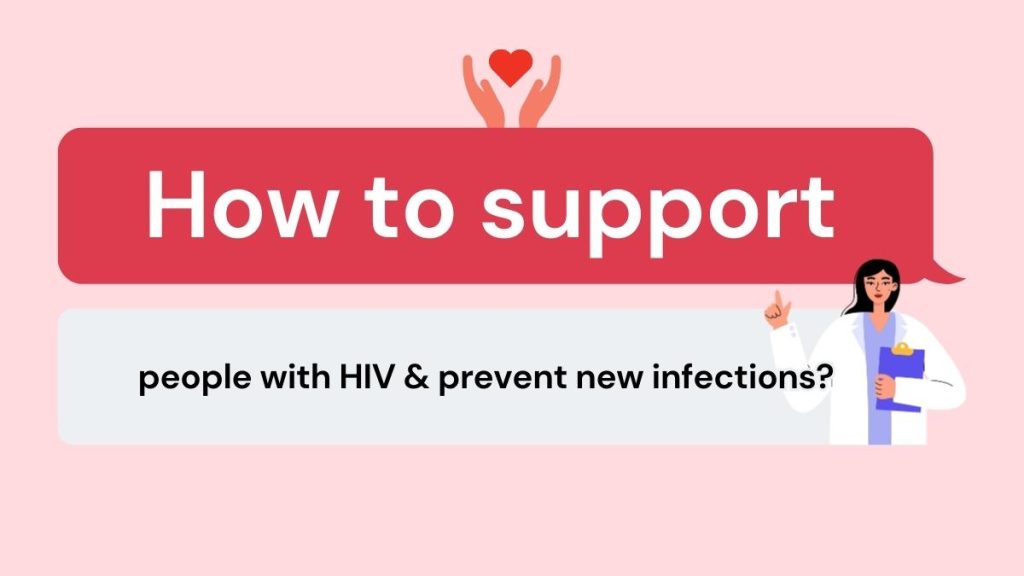How to support people with HIV and prevent new infections. HIV (human immunodeficiency virus) is a virus that attacks the body’s immune system, making it harder for people to fight off infections and diseases. While there is no cure for HIV, advances in treatment have made it possible for people living with HIV to lead long and healthy lives. However, HIV still remains a significant global health issue, with approximately 38 million people living with HIV worldwide and around 1.7 million new HIV infections in 2019 alone. In this article, we will discuss how to support people living with HIV and prevent new infections.
How to support people in preventing HIV?
Preventing new HIV infections is crucial in ending the HIV epidemic. There are several ways to prevent HIV transmission, including
- Condom use and safer sex practices: Using condoms and other barrier methods during sexual activity can greatly reduce the risk of HIV transmission.
- HIV pre-exposure prophylaxis (PrEP) and post-exposure prophylaxis (PEP): PrEP is a daily medication that can be taken to prevent HIV transmission, while PEP is a short-term medication that can be taken after potential exposure to HIV to prevent infection.
- Needle and syringe programs (NSP) and harm reduction strategies: NSPs provide sterile needles and syringes to people who use injection drugs, reducing the risk of HIV transmission through sharing of needles and syringes. Harm reduction strategies also include providing education and support to reduce drug use and prevent HIV transmission.
- HIV education and awareness campaigns: Increasing knowledge and awareness about HIV can help people make informed decisions about their sexual health and reduce the stigma associated with HIV.

How to support people in getting an HIV test?
Getting tested for HIV is important for early diagnosis and treatment. There are several types of HIV tests, including rapid tests, oral fluid tests, and blood tests. HIV self-testing is also available in some countries, which allows people to test for HIV in the privacy of their own homes. It is important to get tested regularly, particularly if you are sexually active or engage in other behaviors that may put you at risk for HIV.
Diffent methods of HIV testing
There are different methods used to test for HIV infection, including:
- Antibody tests: These tests detect the presence of antibodies that the body produces in response to HIV infection. They are also known as “rapid tests” or “point-of-care tests” because they can provide results in 20-30 minutes. Examples of antibody tests include the rapid oral HIV test, the rapid finger prick blood test, and the rapid self-test kit.
- Antigen/antibody tests: These tests detect both HIV antibodies and antigens, which are proteins produced by the virus itself. Antigen/antibody tests can detect HIV infection earlier than antibody tests alone. They are usually performed on a blood sample and can take several days to provide results.
- Nucleic acid tests (NATs): These tests directly detect the genetic material of the virus, either RNA or DNA. NATs are the most sensitive type of HIV test and can detect HIV infection within a few days of exposure. However, they are more expensive and time-consuming than other types of tests and are usually only used in certain situations, such as to confirm a positive antibody or antigen/antibody test result.
It’s important to note that all HIV tests have a window period, which is the time between when a person is infected with HIV and when the test can detect the virus. During this time, a person can have a negative test result even though they are infected with HIV. Therefore, it’s important to get tested regularly if you are at risk of HIV infection, and to follow up with a healthcare provider if you have any concerns or symptoms of HIV.
How to support people in getting HIV treatment?
HIV, or Human Immunodeficiency Virus, is a viral infection that attacks the body’s immune system. The virus weakens the immune system by destroying CD4 cells, a type of white blood cell that helps the body fight off infections. Without treatment, HIV can lead to AIDS (Acquired Immunodeficiency Syndrome), a condition that makes the body vulnerable to a wide range of life-threatening infections and cancers.
For many years, HIV was considered a death sentence because there was no effective treatment for the virus. However, advances in medical research have led to the development of highly effective treatments that can control the virus and prevent the progression to AIDS. While there is still no cure for HIV, treatment has revolutionized the outlook for people living with the virus.
HIV Medications
HIV treatment involves the use of antiretroviral therapy (ART), which is a combination of medications that work together to keep the virus under control. ART involves taking a combination of at least three different medications from different drug classes. These medications target different stages of the virus’s life cycle, preventing it from replicating and reducing the amount of virus in the body.
ART is highly effective in controlling HIV and preventing the progression to AIDS. Studies have shown that people living with HIV who take ART as prescribed can have a near-normal life expectancy and a greatly reduced risk of developing AIDS-related illnesses.
There are several different types of antiretroviral medications used in HIV treatment, including:
- Nucleoside reverse transcriptase inhibitors (NRTIs): These drugs block the action of reverse transcriptase. An enzyme that the virus uses to replicate itself. Examples of NRTIs include tenofovir, emtricitabine, and abacavir.
- Non-nucleoside reverse transcriptase inhibitors (NNRTIs): These drugs also block the action of reverse transcriptase. But in a different way than NRTIs. Examples of NNRTIs include efavirenz and nevirapine.
- Protease inhibitors (PIs): These drugs block the action of protease. An enzyme that the virus uses to break down large proteins into smaller ones. Examples of PIs include atazanavir and darunavir.
- Integrase inhibitors (INSTIs): These drugs block the action of integrase. An enzyme that the virus uses to integrate its genetic material into the DNA of host cells. Examples of INSTIs include raltegravir and dolutegravir.
- Entry inhibitors: These drugs block the virus from entering host cells. Examples of entry inhibitors include maraviroc and enfuvirtide.
HIV Cure
Despite significant progress in HIV treatment, there is still no cure for the virus. HIV can persist in the body even when the virus is undetectable in the blood. And treatment must be continued for life to prevent the virus from replicating and causing damage to the immune system.
New Approaches to HIV Cure
There have been several attempts to develop a cure for HIV, but so far, none have been successful. One of the biggest challenges in developing a cure. Is that the virus can hide in cells and tissues throughout the body, making it difficult to completely eliminate. Another challenge is that HIV is constantly evolving. Making it difficult to develop a single cure that will work for all strains of the virus.
However, researchers are continuing to explore new approaches to HIV cure, including
- Gene therapy: This involves modifying a person’s own cells to make them resistant to HIV. One approach involves using CRISPR/Cas9 gene-editing technology. To remove the CCR5 receptor from CD4 cells, which the virus uses to enter cells.
- Immune-based therapies: These therapies involve boosting the immune system to better control the virus. One approach involves using antibodies that target HIV-specific proteins to help the immune system recognize and destroy infected cells.
- Latency-reversing agents: These drugs are designed to reactivate latent HIV. Making it visible to the immune system and allowing it to be eliminated. One example of a latency-reversing agent is the drug vorinostat.
- Stem cell transplantation: This involves replacing a person’s bone marrow with stem cells from a donor. Who has a genetic mutation that makes them resistant to HIV. This approach has been successful in curing a small number of people with HIV. But it is not practical for most people with the virus.
While a cure for HIV remains elusive. Advances in HIV treatment have transformed the lives of people living with the virus. With proper treatment and care, people with HIV can lead long healthy lives and prevent transmission of the virus to others. In addition to ART, other important aspects of HIV treatment include regular monitoring of the virus and immune system. As well as management of other health conditions that can occur as a result of HIV infection.

There is no cure for HIV. Effective treatment with antiretroviral therapy has greatly improved the outlook for people living with the virus. Ongoing research into new approaches to HIV cure may one day lead to a cure. But in the meantime, people living with HIV can lead long and healthy lives with proper treatment and care. It is important for individuals at risk of HIV infection to get tested regularly. And to seek out appropriate medical care if they test positive for the virus.
How to Support People Regarding HIV Stigma & Discrimination?
HIV-related stigma and discrimination can have a significant impact on the lives of people living with HIV, leading to isolation, shame, and discrimination. Addressing stigma and discrimination in healthcare settings is crucial in ensuring that people living with HIV receive quality care and support. Creating safe spaces for people living with HIV, where they can connect with others who have shared experiences and receive support without fear of judgment, can also help to combat stigma and discrimination.
Support People Living with HIV
Social support is crucial for people living with HIV. As it can help to reduce feelings of isolation and improve overall health outcomes. Being an ally to people living with HIV involves treating them with respect and dignity. Advocating for their rights, and creating an inclusive and welcoming environment. Addressing HIV-related mental health issues, such as depression and anxiety, is also important in supporting people living with HIV.
Supporting people living with HIV and preventing new infections requires a multifaceted approach that involves a combination of prevention, testing, treatment, and support. By increasing knowledge and awareness about HIV. Reducing stigma and discrimination, and providing quality care and support to people living with HIV. We can work towards ending the HIV epidemic and ensuring that everyone can live healthy and fulfilling lives.

